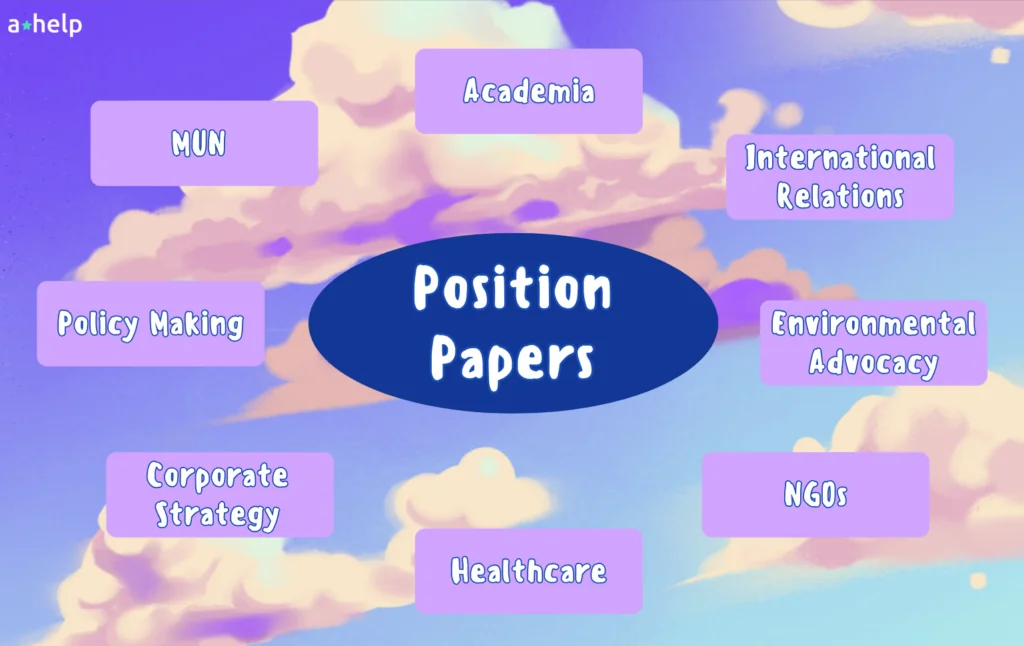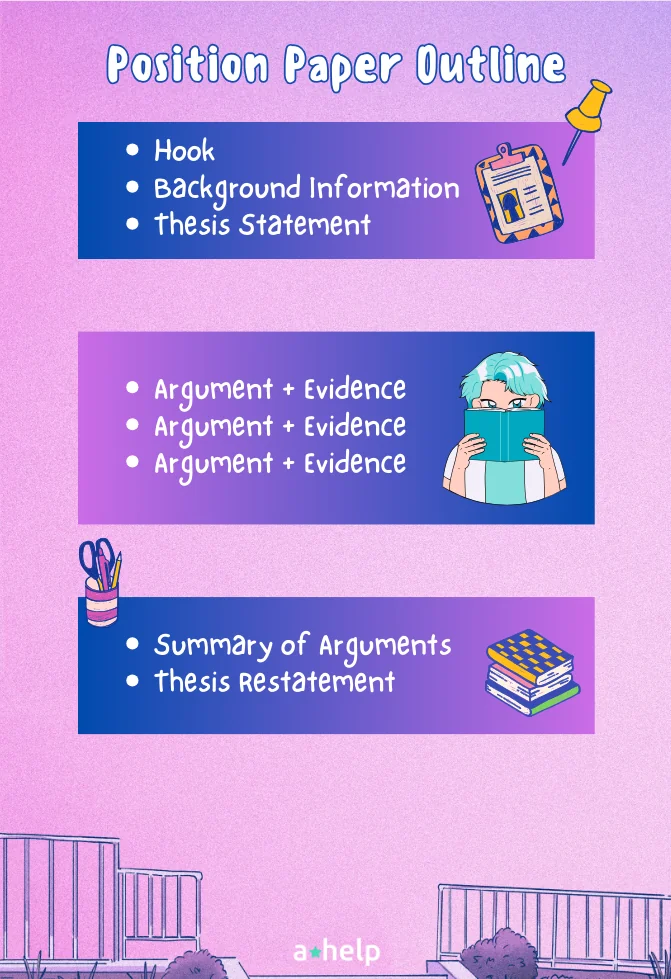When you think about writing in school or at work, several types pop up, right? Essays, reports, and even quick emails. But there’s this one type that doesn’t always get the spotlight, yet it’s super important— the position paper. This paper is your chance to take a stand on an issue and persuade others to see things your way. Imagine you’re trying to convince your friends to try out your favorite restaurant—that’s kind of what you’re doing here, but with more research and organization. Writing a position paper really boils down to three things: being clear, being persuasive, and keeping your arguments organized. Get these right, and you’ll not only present your ideas clearly but might just change some minds too. Whether it’s for a class debate or a proposal at work, understanding how to craft a solid position paper can really make a difference.

✅ AI Essay Writer ✅ AI Detector ✅ Plagchecker ✅ Paraphraser
✅ Summarizer ✅ Citation Generator
What Is a Position Paper?
So, you’ve been asked to write a position paper and you’re thinking, “What exactly is that?” No worries, let’s break it down. A position paper is like your chance to play the role of a lawyer in writing. It’s not about merely stating your opinion – it’s about convincing others that your stance on an issue is the sound choice. This involves digging up evidence, laying down arguments, and showing why your position makes the most sense.
These papers are a big deal in several areas. In academia, students write them to showcase their understanding of a topic and persuade their instructor or peers. If you’re involved in Model United Nations, you’ll definitely be writing position papers to represent your assigned country’s policies and propose solutions. And it doesn’t stop there—position papers are also a thing in the professional world, especially in advocacy, where influencing policy decisions or public perception is the game.

The goal? To inform, persuade, and provide a solid foundation for debate. Whether you’re arguing for less homework, defending a country’s stance on climate change, or advocating for social reforms, your position paper is your voice, formalized in a powerful, structured way. It’s all about making your case as convincingly as possible, backed by facts and clear reasoning. So, when you sit down to write one, think about how you can get your reader to nod along with your points by the time they’re done reading.
Position Paper Format – Pages, Margins, Font
When you’re gearing up to write a position paper, getting the format right is key. Typically, these papers are brief – about 1-2 pages. You’ll want to use a standard font like Times New Roman, size 12, with 1-inch margins all around. This keeps your work readable and professional.
Why stick to these guidelines? Well, following the specific format requested by your instructor or the organization you’re writing for shows that you pay attention to detail and respect the rules of the game. It’s about playing by the rules so that your ideas get heard in the way you intend. It doesn’t matter if it’s for school, a conference, or a competition, because nailing the format can make or break the effectiveness of your argument. So, double-check those guidelines and format your paper to fit perfectly within the expected framework.
Crafting Your Position Paper Outline
Ready to put together your position paper? Let’s break down how to structure it so that your arguments hit just right. A solid position paper typically includes three main parts: an introduction, body paragraphs, and a conclusion. Here’s what you should aim to include in each section:
Introduction: Kick off your paper with an introduction that grabs attention. Start with a hook—an interesting fact or question that piques interest. Next, provide some background on the issue you’re addressing, setting the stage for your arguments. Most crucially, end your introduction with a clear thesis statement. This is your main argument condensed into one or two sentences, stating your position clearly and decisively.
Body Paragraphs: Your body paragraphs are where you delve into the details. Each paragraph should focus on a single point that supports your thesis statement. Start each paragraph with a topic sentence that introduces the point. Follow up with evidence—facts, quotes, or data—that bolsters your argument. Make sure to explain how this evidence relates to your thesis. It’s not just about throwing in information; it’s about making a case that supports your stance.
Conclusion: Wrap up your position paper with a strong conclusion. Restate your thesis in a fresh way, summarizing how the points you made back it up. Then, go beyond by suggesting what could happen next or what actions readers might consider. The conclusion is your last chance to reinforce your position and leave a lasting impression, so make it count!
Remember that each part of your paper should work together seamlessly, creating a clear and persuasive argument that’s hard to refute. Keep your writing focused, back up your points with solid evidence, and you’ll be set for success!
Position Paper Template
Ready to write a position paper but not sure where to start? No stress, we’ve got you covered with a simple step-by-step template. Let’s say you’re writing about the impact of digital media on learning. If you wan’t a TLDR or a quick structure to refer to, we got you.

And if you’re here for a full explanation, check out how you might structure your paper in more detail.
Introduction
- Hook: Start with a compelling statement or question to grab attention. For example, “Did you know that 95% of teens have access to a smartphone? Imagine the educational potential!”
- Background Information: Provide some context about the topic. Mention how digital media has become intertwined with daily life, particularly in education.
- Thesis Statement: Clearly state your position. For instance, “This paper argues that digital media enriches the learning environment by providing accessible and diverse educational resources.”
Body Paragraphs
- Argument 1 with Evidence: Start with your first major point. Maybe you argue that digital media offers unprecedented access to information. Support this with statistics about internet usage for educational research or examples of educational apps.
- Argument 2 with Evidence: Next, discuss how digital media promotes interactive learning. Cite studies that show improved engagement and learning outcomes when digital tools are used in the classroom.
- Further Arguments as Necessary: If you have more points, continue to develop each one in its own paragraph. For example, you might address concerns about screen time but counter with research on controlled usage and its benefits.
Conclusion
- Summary of Arguments: Briefly recap the points you made, reinforcing how digital media supports learning.
- Restatement of the Thesis: Reinforce your thesis statement in a fresh way, tying back to the evidence discussed. You might conclude with, “Digital media, when integrated thoughtfully, not only complements traditional education but also opens new avenues for engagement and accessibility.”
And there you have it—a structured position paper that’s clear, compelling, and sure to impress. Just remember to tailor each section to support your thesis, keep your evidence credible, and your arguments clear. Writing a position paper might seem big, but with this template, you’re well on your way to arguing your point effectively.
How to Write a Position Paper – Essential Tips
Writing a position paper can feel overwhelming (how can you persuade people the way you want?), but with the right approach, you can make a compelling argument that’s hard to ignore. Here are some tips to help you write a clear and to-the-point position paper:
- Conduct thorough research. Before you start writing, gather as much information as possible. Use credible sources to back up your claims and provide a solid foundation for your arguments. The more evidence you have, the stronger your position will be.
- Stay objective. While a position paper requires you to take a stance, staying objective is key. Acknowledge counterarguments and consider different perspectives. This not only shows that you’ve thought things through but also strengthens your position by addressing potential criticisms head-on.
- Maintain a formal tone. Even if the topic is something you’re passionate about, keep your language formal and professional. This helps to convey seriousness and credibility, making your argument more convincing to the reader.
- Use convincing language. Choose your words carefully. Using strong, assertive language can help persuade your audience. However, avoid being overly aggressive; your goal is to persuade, not alienate.
- Be clear and concise. Clarity is a must in a position paper. Make sure your points are clear and your arguments are easy to follow. Avoid unnecessary jargon and complexities that could confuse the reader.
- Plan your structure. A well-organized paper is easier to understand. Make sure each paragraph has a clear point that supports your overall argument, and that your paper flows logically from one point to the next.
You’ll be able to craft a position paper that not only presents your case effectively but also engages and persuades your audience by following these tips. Keep in mind, the strength of your position paper lies in how well you argue your point and back it up with solid evidence. Good luck!
FAQ
Follow us on Reddit for more insights and updates.





Comments (0)
Welcome to A*Help comments!
We’re all about debate and discussion at A*Help.
We value the diverse opinions of users, so you may find points of view that you don’t agree with. And that’s cool. However, there are certain things we’re not OK with: attempts to manipulate our data in any way, for example, or the posting of discriminative, offensive, hateful, or disparaging material.